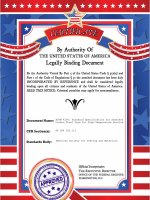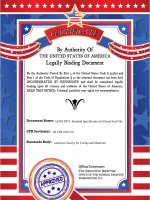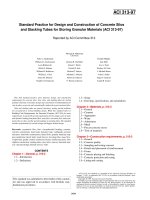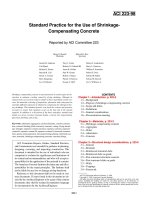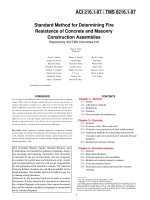standard specification for cold weather concreting
Bạn đang xem bản rút gọn của tài liệu. Xem và tải ngay bản đầy đủ của tài liệu tại đây (269.41 KB, 5 trang )
This document has been approved for use by agen-
cies of the Department of Defense and for listing in
306.1-90
the
DoD
Index of Specifications and Standards.
(Reapproved 2002)
Standard Specification for Cold Weather Concreting (306.1-90)
Reported by ACI Committee 306
Nicholas J. Carino, Chairman*
Fred Anderson*
Peter Antonich
George R. U. Burg
Oleh B. Ciuk
Douglas J. Haavik*
Gilbert
Haddad
Jules Houde
David A. Hunt
Robert A. Kelsey
Albert W. Knott
Charles J. Korhonen
William Perenchio*
John M. Scanlon
Michael Shydlowski
Bruce A. Suprenant
J. Derle Thorpe
Valery Tokar
Lewis H. Tuthill*
Harold B. Wenzel
Arthur T. Winters
This Standard Specification gives requirements for cold weather con-
creting. It includes cold weather requirements for preparations prior
to placement of concrete, and protection of concrete.
Keywords: accelerating admixtures; cold weather; compressive strength; con-
struction; curing; formwork; freezing; heating; insulation; maturity; protec-
tion; temperature.
FOREWORD
Fl.
This foreword is included for explanatory pur-
poses only; it does not form a part of the Standard
Specification
ACI
306.1.
F2. Standard Specifications
ACI
306.1 is a Reference
Standard which the Architect/Engineer may cite in the
Project Specifications for any building project, to-
gether with supplementary requirements for the spe-
cific project.
F3. Each technical section of Standard Specification
ACI
306.1 is written in the Three-Part Section Format
of the Construction Specifications Institute, as adapted
by
ACI
and modified to
ACI
requirements. The lan-
guage is generally imperative and terse.
F4. Checklists do not form a part of Standard Spec-
ification
ACI
306.1. Checklists are to assist the Archi-
tect/Engineer in properly choosing and specifying any
necessary requirements for the Project Specifications.
PREFACE TO SPECIFICATION CHECKLIST
Pl. Standard Specification
ACI
306.1 is intended to
be used by reference or incorporation in its entirety in
the Project Specifications. Individual sections, articles,
or paragraphs shall not be copied into the Project
Specifications, since taking them out of context may
change their meaning.
*Task force for revision.
Supercedes ACI 306.1-87. Revised by the Expedited Standardization Proce-
dure, effective July 1, 1990. In 1990, the format was revised. The Foreword,
Preface, and Specification Checklist were revised. Reference Standards were
updated and the sections on Materials and Execution were rewritten and re-
numbered.
P2. If sections or parts of Standard Specification
ACI
306.1 are edited into project specifications or any
other document, they shall not be referred to as
ACI
Standards, since the Standard Specification has been
altered.
P3. Building codes set minimum requirements neces-
sary to protect the public. This Standard Specifica-
tion may stipulate requirements more restrictive than
the minimum. Adjustments to the needs of a particular
project shall be made by the Architect/Engineer by re-
viewing each of the items in the Specification Check-
list and then including the Architect/Engineer’s deci-
sion on each item as a mandatory requirement in the
Project Specifications.
P4. These mandatory requirements designate the
specific qualities, procedures, materials, and perfor-
mance criteria for which alternatives are permitted or
for which provisions were not made in the Standard
Specification. Exceptions to the Standard Specifica-
tion shall be made in the Project Specifications, if re-
quired.
P5.
A statement such as the following will serve to
make Standard Specification
ACI
306.1 a part of the
Project Specifications.
Work on shall conform
to all requirements of
ACI
306.1, Standard Spec-
ification for Cold Weather Concreting, published
by the American Concrete Institute, Detroit,
Michigan, except as modified by the requirements
of these Contract Documents.
P6. The Standard Specification Checklist identifies
Architect/Engineer choices and alternatives. The
checklist identifies the sections, parts, and articles of
the Standard Specification and the action required by
the Architect/Engineer.
Copyright
100
2002, American Concrete Institute. All rights reserved includ-
ing rights of reproduction and use in any form or by any means, including the
making of copies by any photo process or by any electronic or mechanical de-
vice, printed or written or oral, or recording for sound or visual reproduction
or for use in any knowledge or retrieval system or device, unless permission in
writing is obtained from the copyright proprietors.
306.1-1
306.1-2
ACI STANDARD
SPECIFICATION CHECKLIST
M.
MANDATORY REQUIREMENTS
Section/Part/Article of
ACI 306.1 Notes to the Architect/Engineer
1.4 Reference standards
Review applicability of the cited references and take exception if required
3.1 Preparation before concreting
If the temperature of massive embedments, such as heavy steel guide rails or channels and steel grate frames
or ducts, is lower than 32 F, concrete cast around them will be damaged by freezing. Identify in the Contract
Documents massive embedments which must be at a temperature above freezing prior to placement of con-
crete.
A frozen subgrade can lead to freezing of newly-placed concrete or foundation settlement upon subsequent
thawing of the subgrade. Specify in the Contract Documents the depth to which frozen subgrade should be
thawed prior to placement of concrete. Specify procedure to verify that subgrade has been thawed to specified
depth.
3.2.2
Protection temperature
Specify the frequency for recording the temperature but do not use a frequency lower than twice per 24-hr pe-
riod.
3.4.5
Protection for structural safety
Indicate in the Contract Documents the concrete strength required for each structural member before form re-
moval or continued construction, or both.
O. OPTIONAL REQUIREMENTS
Section/Part/Article of
ACI 306.1
Notes to the Architect/Engineer
1.5.1
Detailed procedures
Indicate in the Contract Documents whether submittal, review, and acceptance of procedure is required. Des-
ignate degree of detail required in any submittal procedure.
3.3 Curing concrete
Strength gain may not continue after removal of the protection because of rapid drying in regions where there
are periods of cold, dry, windy weather. Therefore, under these conditions, consideration should be given to
extending the protection period in order to facilitate moist curing.
3.2.2
Protection temperature
Specify the minimum protection temperature if different than Column 2 of Table 3.2.1.
3.4.4
Protection against freezing
l Any changes in the concrete mix proportions for reducing the duration of the protection period to prevent
early freezing should be submitted for review or acceptance.
l For certain structures, the protection period may be reduced if, after 24 hr of protection, the compressive
strength of the in-place concrete is at least 500 psi. The requirements for these structures are that they do not
require early strengths, will undergo little or no freezing and thawing during construction and in service, and
have not been exposed to an external supply of moisture during the protection period.
l
The minimum protection temperature specified in Table 3.2.1 may be reduced provided that the protection
period is extended until the compressive strength of the in-place concrete is at least 500 psi.
l
Note that a compressive strength of 500 psi is only adequate to protect the concrete against damage from one
cycle of freezing and thawing.
l
The specified minimum protection periods are based
on
the assumption that additional curing will be speci-
fied and provided, as needed, prior to putting the structure into service. Longer protection periods may be
specified to assure that desired properties are developed prior to removal of protection.
S. SUBMITTALS
Section/Part/Article of
ACI 306.1
Notes to the Architect/Engineer
1.5 Submittal of procedures
If required, indicate to whom submittals will be sent.
1.5.1
Detailed procedures
Minimum procedures for placement, curing and protection of the concrete may follow the recommendations
in ACI 306R, “Cold Weather Concreting.” The details should include, but not be limited to, the following:
l
Procedures for protecting the subgrade from frost and the accumulation of ice or snow on reinforcement or
forms prior to placement.
l
Methods for temperature protection during placement.
l
Types of covering, insulation, housing, or heating to be provided.
•.Curing methods to be used during and following the protection period.
l
Use of strength accelerating admixtures.
l
Methods for verification of in-place strength.
• Procedures for measuring and recording concrete temperatures.
l
Procedures for preventing drying during dry, windy conditions.
Require detailed procedures for those items of concern for the Work.
COLD WEATHER CONCRETING SPECIFICATION
306.1-3
CONTENTS
1 - General, p. 306.1-3
1.1 - Scope
1.2 - Definitions
1.3 - Reference organizations
1.4 - Reference standards
1.5 - Submittal of procedures
2- Materials, p. 306.1-4
2.1 - Scheduling protection materials
2.2 - Concrete
3- Execution, p. 306.1-4
3.1 - Preparation before concreting
3.2 - Concrete temperature
3.3 - Curing of concrete
3.4 - Protection of concrete
1-
GENERAL
1.1
- Scope
1.1.1
This Standard Specification covers require-
ments for cold weather concreting and protection of
concrete from freezing during the specified protection
period.
1.1.2
The provision of this Standard Specification
shall govern unless otherwise specified in the Contract
Documents.
1.2. -
Definitions
These definitions are to assist in interpreting the pro-
visions of this specification.
Accepted - Accepted by or acceptable to the Archi-
tect/Engineer.
Architect/Engineer -
The architect, engineer, archi-
tectural firm, engineering firm, or architectural and en-
gineering firm issuing Project Drawings and Specifica-
tions, or administering the Work under the Contract
Documents.
Cold weather - A period when for more than three
successive days the average daily outdoor temperature
drops below 40 F. The average daily temperature is the
average of the highest and lowest temperature during
the period from midnight to midnight. When tempera-
tures above 50 F occur during more than half of any 24
hr duration, the period shall no longer be regarded as
cold weather.
Cold weather concreting - Operations concerning
the placing, finishing, curing, and protection of con-
crete during cold weather.
Contractor - The person, firm, or corporation with
whom the Owner enters into an agreement for con-
struction of the Work.
Contract documents - Documents including the
Project Drawings and Project Specifications covering
the required Work.
Day - A time period of 24 consecutive hours.
Owner - The corporation, association, partnership,
individual, or public body or authority with whom the
Contractor enters into an agreement and for whom the
Work is provided.
Project drawings -
The drawings, which along with
the Project Specifications, complete the descriptive in-
formation for constructing the Work required or re-
ferred to in the Contract Documents.
Project specifications - The written documents
which specify requirements for a project in accordance
with the service parameters and other specific criteria
established by the Owner.
Protection period - The required time during which
the concrete is maintained at or above a specific tem-
perature in order to prevent freezing of the concrete or
to ensure the necessary strength development for struc-
tural safety.
Reference standards - Standards of a technical so-
ciety, organization, or association, including the codes
of local or state authorities, which are referenced in the
Contract Documents.
Required - Required by this Specification or the
Contract Documents.
Submitted - Submitted to the Architect/Engineer
for review.
Work - The entire construction or separately iden-
tifiable parts thereof which are required to be fur-
nished under the Contract Documents. Work is the
result of performing services, furnishing labor, and
furnishing and incorporating materials and equipment
into the construction, all as required by the Contract
Documents.
1.3
- Reference organizations
ACI: American Concrete Institute
P.O. Box 19150
Detroit, MI 48219
ASTM: American Society for Testing and Materials
1916 Race Street
Philadelphia, PA 19103
1.4 -
Reference standards
1.4.1
ACI Standards
301-89
Specifications for Structural
Concrete for Buildings
1.4.2
ASTM Standards
C 31-88
Standard Method of Making
and Curing Concrete Test
Specimens in the Field
C 150-86
Standard Specification for
Portland Cement
C 494-86
Standard Specification for
Chemical Admixtures for
Concrete
C 803-82
Standard Test Method for
Penetration Resistance of
Hardened Concrete
306.1-4 ACI STANDARD
C 873-85
C 900-87
Standard Test Method for
Compressive Strength of
Concrete Cylinders Cast in
Place in Cylindrical Molds
Standard Test Method for
Pullout Strength of Hard-
ened Concrete
1.5
-
Submittal of procedures
1.5.1
Detailed procedures
-
If required, submit de-
tailed procedures for the production, transportation,
placement, protection, curing, and temperature moni-
toring of concrete during cold weather. In the submit-
tal, include procedures to be implemented upon abrupt
changes in weather conditions or equipment failures.
Do not begin cold weather concreting until these pro-
cedures have been reviewed and accepted.
2
MATERIALS
2.1 Scheduling protection materials
All materials and equipment required for protection
shall be available at the project site before cold weather
concreting.
2.2
-
Concrete
Concrete for slabs and other flatwork exposed to
cycles of freezing and thawing in a wet condition dur-
ing the construction period shall be air entrained as
specified in ACI 301 even though the concrete may not
be exposed to freezing in service.
EXECUTION
3.1
-
Preparation before concreting
Remove all snow, ice, and frost from the surfaces,
including reinforcement, against which the concrete is
to be placed. Before beginning concrete placement,
thaw the
subgrade
to the depth specified in the Con-
tract Documents. Do not place concrete around mas-
sive embedments identified in the Contract Documents
unless such embedments are at a temperature above
freezing.
3.2
-
Concrete temperature
3.2.1 Placement temperature
-
The minimum tem-
perature of concrete immediately after placement shall
be as specified in Column 2 of Table 3.2.1. The tem-
perature of concrete as placed shall not exceed the val-
ues shown in Column 2 of Table 3.2.1 by more than 20
F.
Table 3.2.1
-
Concrete temperature
(1)
(2)
(3)
Least dimension of
Minimum temperature Maximum gradual
section, in.
of concrete as placed decrease in surface
and maintained during temperature dur-
the protection period, ing any 24 h after
F
end of protection,
F
I I
Less than 12
12 to less than 36
36 to 72
Greater than 72
50
::,
40
45
30
40
20
3.2.2 Protection temperature
-
Unless otherwise
specified, the minimum temperature of concrete during
the protection period shall be as shown in Column 2 of
Table 3.2.1. Temperatures specified to be maintained
during the protection period shall be those measured at
the concrete surface, whether the surface is in contact
with formwork, insulation, or air. Measure the temper-
ature with a surface temperature measuring device hav-
ing an accuracy of
_t2
F. Measure the temperature of
concrete in each placement at regular time intervals as
specified in the Contract Documents.
3.2.3 Termination of protection
-
The maximum
decrease in temperature measured at the surface of the
concrete in a 24-hour period shall not exceed the values
shown in Column 3 of Table 3.2.1. Do not exceed these
limits until the surface temperature of the concrete is
within 20 F of the ambient or surrounding tempera-
tures. When the surface temperature of the concrete is
within 20 F of the ambient or surrounding tempera-
ture, all protection may be removed.
3.3
-
Curing of concrete
Prevent concrete from drying during the required
curing period. If water curing is used, terminate use at
least 24 hr before any anticipated exposure of the con-
crete to freezing temperatures.
3.4
-
Protection of concrete
3.4.1 Combustion heaters
-
Vent flue gases from
combustion heating units to the outside of the enclo-
sure.
3.4.2 Overheating and drying
-
Place and direct
heaters and ducts to avoid areas of overheating or
drying of the concrete surface.
3.4.3
Maximum air temperature
-
During the pro-
tection period, do not expose the concrete surface to air
having a temperature more than 20 F above the values
shown in Column 2 of Table
3.2.1,
unless higher values
are required by an accepted curing method.
3.4.4 Protection against freezing
-
Cure and protect
concrete against damage from freezing for a minimum
period of 3 days, unless otherwise specified. Maintain
the surface temperature of the concrete during that pe-
riod in accordance with Column 2 of Table 3.2.1, un-
less otherwise specified. The protection period may be
reduced to 2 days if use of one or more of the follow-
ing to alter the concrete mixture is accepted:
l Type III
portland
cement meeting the require-
ments of ASTM C 150
l A strength accelerating admixture meeting the re-
quirements of ASTM C 494
l 100 lb/yd³ of additional cement
During periods not defined as cold weather, but when
freezing temperatures may occur, protect concrete sur-
faces against freezing for the first 24 hr after placing.
3.4.5 Protection for structural safety - If the con-
crete strength is required for structural safety, extend
COLD WEATHER CONCRETING SPECIFICATION
306.1-5
the duration of the protection period to ensure the nec-
essary strength development. The strength required for
formwork removal, for reshoring, or for continued
construction shall be as specified in the Contract Doc-
uments for each type of structural member. Verify
whether the required strength has been attained by us-
ing one or more of the following methods:
l ASTM C 31 (use procedures in section titled
“Curing for Determining Form Removal Time
or When a Structure May be Put into Service”)
l ASTM C 803
l ASTM C 873
l ASTM C 900
A correlation with cylinder strength, using the specific
concrete intended for construction, is required for
ASTM test methods C 803 and C 900.
3.4.6 Protection deficiency - If the temperature re-
quirements during the specified protection period are
not met but the concrete was prevented from freezing,
continue protection until twice the deficiency of pro-
tection in degree-hours is made up. Deficient degree-
hours may be determined by multiplying the average
deficiency in temperature by the number of hours the
temperature was below the values shown in Column 2
of Table 3.2.1.
APPENDIX -
METRIC CONVERSIONS

